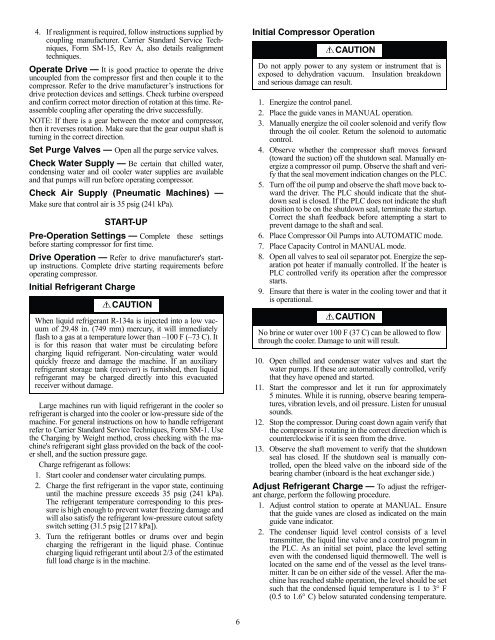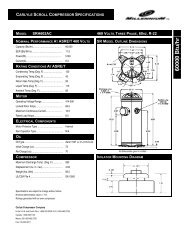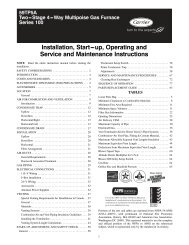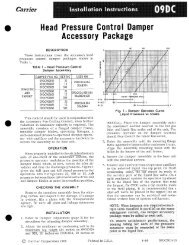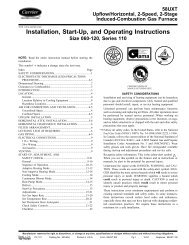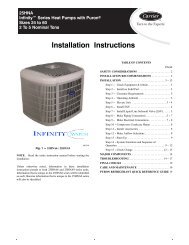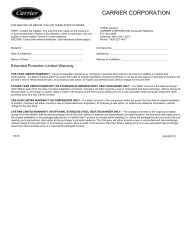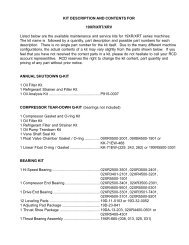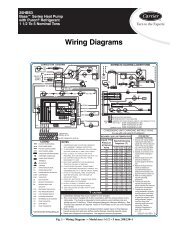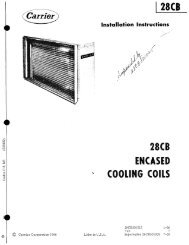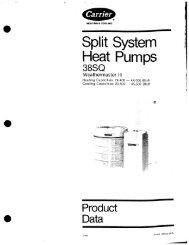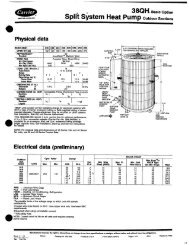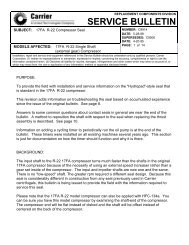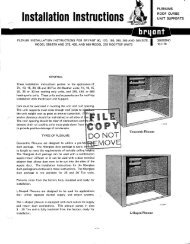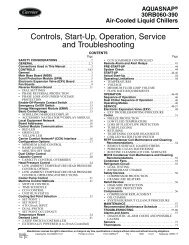Start-Up, Operation, and Maintenance Instructions - Carrier
Start-Up, Operation, and Maintenance Instructions - Carrier
Start-Up, Operation, and Maintenance Instructions - Carrier
You also want an ePaper? Increase the reach of your titles
YUMPU automatically turns print PDFs into web optimized ePapers that Google loves.
4. If realignment is required, follow instructions supplied by<br />
coupling manufacturer. <strong>Carrier</strong> St<strong>and</strong>ard Service Techniques,<br />
Form SM-15, Rev A, also details realignment<br />
techniques.<br />
Operate Drive — It is good practice to operate the drive<br />
uncoupled from the compressor first <strong>and</strong> then couple it to the<br />
compressor. Refer to the drive manufacturer’s instructions for<br />
drive protection devices <strong>and</strong> settings. Check turbine overspeed<br />
<strong>and</strong> confirm correct motor direction of rotation at this time. Reassemble<br />
coupling after operating the drive successfully.<br />
NOTE: If there is a gear between the motor <strong>and</strong> compressor,<br />
then it reverses rotation. Make sure that the gear output shaft is<br />
turning in the correct direction.<br />
Set Purge Valves — Open all the purge service valves.<br />
Check Water Supply — Be certain that chilled water,<br />
condensing water <strong>and</strong> oil cooler water supplies are available<br />
<strong>and</strong> that pumps will run before operating compressor.<br />
Check Air Supply (Pneumatic Machines) —<br />
Make sure that control air is 35 psig (241 kPa).<br />
START-UP<br />
Pre-<strong>Operation</strong> Settings — Complete these settings<br />
before starting compressor for first time.<br />
Drive <strong>Operation</strong> — Refer to drive manufacturer's startup<br />
instructions. Complete drive starting requirements before<br />
operating compressor.<br />
Initial Refrigerant Charge<br />
CAUTION<br />
When liquid refrigerant R-134a is injected into a low vacuum<br />
of 29.48 in. (749 mm) mercury, it will immediately<br />
flash to a gas at a temperature lower than –100 F (–73 C). It<br />
is for this reason that water must be circulating before<br />
charging liquid refrigerant. Non-circulating water would<br />
quickly freeze <strong>and</strong> damage the machine. If an auxiliary<br />
refrigerant storage tank (receiver) is furnished, then liquid<br />
refrigerant may be charged directly into this evacuated<br />
receiver without damage.<br />
Large machines run with liquid refrigerant in the cooler so<br />
refrigerant is charged into the cooler or low-pressure side of the<br />
machine. For general instructions on how to h<strong>and</strong>le refrigerant<br />
refer to <strong>Carrier</strong> St<strong>and</strong>ard Service Techniques, Form SM-1. Use<br />
the Charging by Weight method, cross checking with the machine's<br />
refrigerant sight glass provided on the back of the cooler<br />
shell, <strong>and</strong> the suction pressure gage.<br />
Charge refrigerant as follows:<br />
1. <strong>Start</strong> cooler <strong>and</strong> condenser water circulating pumps.<br />
2. Charge the first refrigerant in the vapor state, continuing<br />
until the machine pressure exceeds 35 psig (241 kPa).<br />
The refrigerant temperature corresponding to this pressure<br />
is high enough to prevent water freezing damage <strong>and</strong><br />
will also satisfy the refrigerant low-pressure cutout safety<br />
switch setting (31.5 psig [217 kPa]).<br />
3. Turn the refrigerant bottles or drums over <strong>and</strong> begin<br />
charging the refrigerant in the liquid phase. Continue<br />
charging liquid refrigerant until about 2/3 of the estimated<br />
full load charge is in the machine.<br />
6<br />
Initial Compressor <strong>Operation</strong><br />
CAUTION<br />
Do not apply power to any system or instrument that is<br />
exposed to dehydration vacuum. Insulation breakdown<br />
<strong>and</strong> serious damage can result.<br />
1. Energize the control panel.<br />
2. Place the guide vanes in MANUAL operation.<br />
3. Manually energize the oil cooler solenoid <strong>and</strong> verify flow<br />
through the oil cooler. Return the solenoid to automatic<br />
control.<br />
4. Observe whether the compressor shaft moves forward<br />
(toward the suction) off the shutdown seal. Manually energize<br />
a compressor oil pump. Observe the shaft <strong>and</strong> verify<br />
that the seal movement indication changes on the PLC.<br />
5. Turn off the oil pump <strong>and</strong> observe the shaft move back toward<br />
the driver. The PLC should indicate that the shutdown<br />
seal is closed. If the PLC does not indicate the shaft<br />
position to be on the shutdown seal, terminate the startup.<br />
Correct the shaft feedback before attempting a start to<br />
prevent damage to the shaft <strong>and</strong> seal.<br />
6. Place Compressor Oil Pumps into AUTOMATIC mode.<br />
7. Place Capacity Control in MANUAL mode.<br />
8. Open all valves to seal oil separator pot. Energize the separation<br />
pot heater if manually controlled. If the heater is<br />
PLC controlled verify its operation after the compressor<br />
starts.<br />
9. Ensure that there is water in the cooling tower <strong>and</strong> that it<br />
is operational.<br />
CAUTION<br />
No brine or water over 100 F (37 C) can be allowed to flow<br />
through the cooler. Damage to unit will result.<br />
10. Open chilled <strong>and</strong> condenser water valves <strong>and</strong> start the<br />
water pumps. If these are automatically controlled, verify<br />
that they have opened <strong>and</strong> started.<br />
11. <strong>Start</strong> the compressor <strong>and</strong> let it run for approximately<br />
5 minutes. While it is running, observe bearing temperatures,<br />
vibration levels, <strong>and</strong> oil pressure. Listen for unusual<br />
sounds.<br />
12. Stop the compressor. During coast down again verify that<br />
the compressor is rotating in the correct direction which is<br />
counterclockwise if it is seen from the drive.<br />
13. Observe the shaft movement to verify that the shutdown<br />
seal has closed. If the shutdown seal is manually controlled,<br />
open the bleed valve on the inboard side of the<br />
bearing chamber (inboard is the heat exchanger side.)<br />
Adjust Refrigerant Charge — To adjust the refrigerant<br />
charge, perform the following procedure.<br />
1. Adjust control station to operate at MANUAL. Ensure<br />
that the guide vanes are closed as indicated on the main<br />
guide vane indicator.<br />
2. The condenser liquid level control consists of a level<br />
transmitter, the liquid line valve <strong>and</strong> a control program in<br />
the PLC. As an initial set point, place the level setting<br />
even with the condensed liquid thermowell. The well is<br />
located on the same end of the vessel as the level transmitter.<br />
It can be on either side of the vessel. After the machine<br />
has reached stable operation, the level should be set<br />
such that the condensed liquid temperature is 1 to 3° F<br />
(0.5 to 1.6° C) below saturated condensing temperature.


